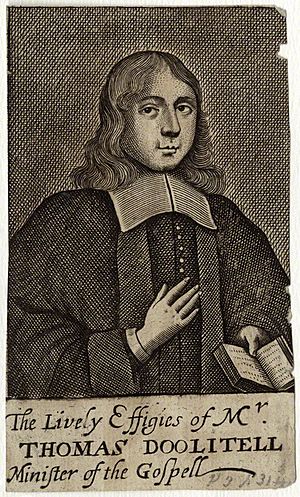Thomas Doolittle facts for kids
Thomas Doolittle (around 1632–1707) was an important English minister, teacher, and writer. He was known for being a "nonconformist," which meant he didn't follow the official rules of the Church of England during a time when it was difficult to do so. He taught many students and wrote several books.
Contents
Early Life and Education
Thomas Doolittle was born in Kidderminster, England, around 1632. His father, Anthony Doolittle, was a glover (someone who makes gloves). When Thomas was young, he went to grammar school in his hometown. There, he heard a famous preacher named Richard Baxter. Baxter's sermons had a big impact on Thomas, inspiring him deeply.
Thomas first thought about becoming a lawyer. However, he didn't like the idea of working on Sundays, so he decided against it. Richard Baxter encouraged him to become a minister instead.
In 1649, when he was about 17, Thomas went to Pembroke Hall, which is part of Cambridge University. He studied hard and earned his Master of Arts (M.A.) degree. After finishing university, he moved to London. He became a very popular preacher and, in 1653, was chosen to be the pastor (leader) of the church in St. Alphage, London Wall. He was officially ordained as a Presbyterian minister.
Becoming a Nonconformist
In 1662, a new law called the Uniformity Act 1662 was passed. This law made strict rules about how churches should be run and what ministers had to believe. Thomas Doolittle felt it was his duty to not follow these new rules, even though it meant he would lose his job and become poor. He chose to be a nonconformist.
After leaving his church job, he moved to Moorfields and started a boarding school. The school was very successful. He then moved to a bigger house in Bunhill Fields, where another minister, Thomas Vincent, helped him teach.
Challenges and Teaching
In 1665, during the terrible Great Plague, Thomas Doolittle and his students moved out of London to Woodford Bridge for safety. Thomas Vincent stayed behind in the city.
When Thomas Doolittle returned to London in 1666, after the Great Fire had destroyed many churches, he and other nonconformist ministers started holding services in new places. His first meeting-house was in Bunhill Fields. Later, he built a large building in Mugwell (now Monkwell) Street for his congregation.
However, the authorities tried to stop him from preaching. The Lord Mayor asked him to stop, but Thomas refused. One night, soldiers broke into his house to arrest him, but he escaped over a wall. The next day, a friend preached in his place, and soldiers interrupted the service. The meeting-house was taken over by the king's name and used as a chapel.
In 1672, King Charles II allowed some freedom for nonconformists. Thomas Doolittle got a license for his meeting-house. He also moved his school, which had grown into an academy for advanced learning, to Islington. When the king took back his declaration of freedom in 1673, Doolittle had to be very careful. He moved his academy to Wimbledon to avoid arrest.
He returned to Islington before 1680, but in 1683, he had to move again. He went to Battersea (where his belongings were taken) and then to Clapham. These moves made it very hard to keep his academy going. Many important students, like Matthew Henry and Edmund Calamy, studied with him. Two of his students, John Kerr and Thomas Rowe, became well-known nonconformist teachers themselves. By 1687, his academy had closed.
Later Life and Works
In 1689, the Toleration Act was passed. This law finally allowed nonconformists to worship freely. Thomas Doolittle was able to return to his meeting-house in Mugwell Street. He preached twice every Sunday and gave lectures on Wednesdays.
His book, Body of Divinity, was a longer explanation of a famous religious text called the Westminster Assembly's shorter catechism. He also wrote a personal religious agreement in 1693, which was very detailed.
Thomas Doolittle suffered from health problems for a long time. However, his last illness was short. He preached and taught on Sunday, May 18, 1707. He became unconscious a few days later and passed away on May 24, 1707. He was the last of the London ministers who had been forced out of their churches in 1662.
Writings
Thomas Doolittle wrote about twenty books and sermons. Some of his most well-known works include:
- 'Sermon on Assurance in the Morning Exercise at Cripplegate' (1661)
- 'A Treatise concerning the Lord's Supper' (1665)
- 'A Call to Delaying Sinners' (1683) – both of these books were printed many times.
His last book published while he was alive was:
- 'The Saint's Convoy to, and Mansions in Heaven' (1698).
After he died, another book was published:
- 'A Complete Body of Practical Divinity' (1723). This book was based on his Wednesday lectures.
Family Life
Thomas Doolittle got married in 1653. His wife passed away in 1692. They had three sons and six daughters. By 1723, all of his children had passed away except for one daughter.


